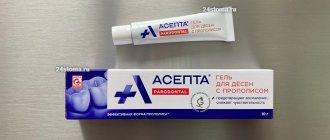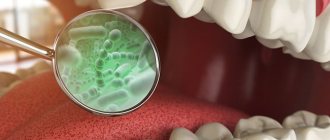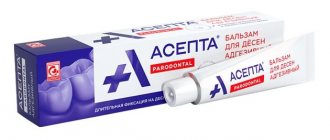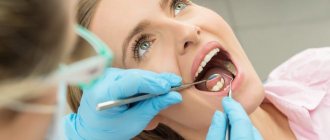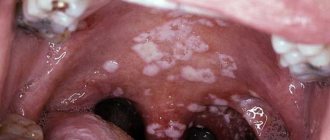From this article you will learn:
- instructions for use, reviews,
- price for Asepta gel in pharmacies,
- differences in composition between Asepta gel and balm.
The article was written by a dentist with more than 19 years of experience.
Asepta gum gel is a dental preparation in gel form used to treat inflammation of the oral mucosa and gums. This drug is the only gel for gums in Russian pharmacies, whose active component is a beekeeping product - propolis. It should be noted that this drug is not registered as a “drug” and therefore it belongs only to the “parapharmaceutical” category.
The drug is produced in Russia. Inside the cardboard package (in addition to the tube with the gel) there is a plastic spatula intended for applying the gel to the gums. You may feel a little weird at first when using this applicator to apply gel to your gums, but it actually does a better job than using your finger. In addition to Asepta gel, there is also ASEPTA in the form of an adhesive balm. This drug no longer contains propolis, but a combination of the antibiotic metronidazole and the antiseptic chlorhexidine.
ASEPTA in the form of gel and balm for gums: photo
Asepta gum balm, thanks to chlorhexidine and metronidazole, has a much more pronounced antimicrobial effect on pathogenic microflora. This drug will be much more effective in the acute phase of inflammation - compared to its propolis-based version. You can read more about adhesive gum balm here , and in this article we will focus in detail on the gel form.
Indications for use –
- with gingivitis,
- with periodontitis,
- trophic ulcers of the oral mucosa,
- for stomatitis (for epithelization of erosions/aphthae).
Instructions for using Asepta gum gel contain all of the above indications, but not with all of them - you can get a good effect. Each of these indications requires clarification, and therefore we will analyze in detail in our article all the features of using this gel in the treatment of inflammatory processes in the oral cavity.
Asepta Gel: price, composition
For Asepta gum gel, the price for 2022 will be from 240 rubles. The drug has a single release form - in metal tubes of 10 g. The drug is produced by the pharmaceutical company Vertex (Russia), and should certainly be of interest to people who are interested in beekeeping products.
The gel has a viscous consistency and adheres well to the marginal gum around the teeth (it is not washed off with saliva). The gel has a light yellow color and is completely opaque. When applied to the gums, the characteristic pleasant taste of beekeeping products is immediately felt. The packaging contains an applicator for applying the gel to the gums, but it cannot be said that it is too convenient (see photo below).
Applicator and composition of the drug on the package –
Asepta gel for gums: composition
| Content of active substances – → natural propolis extract 10% |
| Auxiliary ingredients – propylene glycol, carbomer, hydrogenated castor oil, triethanolamine, disodium edetate, sodium saccharinate, methylparaben, PEG-40, water. |
→ Asepta gel for gums: instructions for use (download in PDF)
Composition analysis –
For Asepta gum gel, the instructions for use contain information that the drug has antimicrobial, anti-inflammatory, wound healing, and analgesic effects. This is true, but this action will not be too pronounced. The anti-inflammatory effect of propolis is very moderate and short-lived, so the drug is more suitable for courses to prevent exacerbation of gum inflammation, but not for the treatment of acute or chronic inflammation.
In addition, upon closer examination of the antimicrobial effect, it turns out that propolis does not act on all types of pathogenic bacteria. For example, it affects gram-positive bacteria, but is absolutely ineffective against gram-negative and anaerobic bacteria (and it is the latter that play an active role in periodontitis). The analgesic effect is minimal and short-lived, and the gel does not have a cooling effect.
The gel can be used as a wound healing agent, but with caution. For example, this should never be done in case of aphthous stomatitis, in which erosions (ulcerations) form on the oral mucosa. The cause of this form of stomatitis in half of the cases may be an allergic reaction, and given that propolis itself is a very allergenic product, it is not advisable to use it in this case.
Conclusions: we recommend using Asepta gel for gums only as a maintenance agent between courses of professional anti-inflammatory therapy. It makes no sense to use this gel to treat gingivitis or periodontitis, because... it does not have sufficient anti-inflammatory or antimicrobial effects. And even its combination with one of the strong antiseptic mouth rinses will not give a good effect.
ASEPTA gel for gums: instructions for use
Asept gel for gums instructions contain information that the gel should be used only after brushing your teeth, applying it in a thin layer to the affected (inflamed) surfaces of the oral mucosa and gums. Before using the gel, it is advisable to additionally dry these surfaces with a dry gauze swab (this will improve the fixation of the gel on the moist mucous membrane). After applying the gel, you should not drink water for at least 30 minutes, and do not eat or rinse your mouth for 2-3 hours after application.
The drug should be used in a course, using it 2-3 times a day for 7-14 days. Preventive courses are carried out 2-3 times a year. Before the course of prevention, it is advisable to visit a periodontist to remove dental plaque, otherwise you will not see much effect from using this remedy (24stoma.ru).
Analogs of Asept gel –
An indirect analogue of the drug can be called Cholisal DENTAL gel, which contains aprotinin. The latter is an antioxidant that stabilizes the walls of blood vessels (reduces their permeability), which leads to a reduction in swelling and symptoms of gum inflammation. The drug Cholisal Dental should also be used only to prevent exacerbation of inflammation, and not to treat active inflammation. Those. it is also used only between professional courses of anti-inflammatory therapy, which are carried out using antiseptics, antibiotics, etc.
The drug "Cholisal DENTAL":
Asepta toothpastes
Cleanliness of the oral cavity and the absence of bacteria here is the key and basis for the health of gums and teeth. This is what Asepta pastes do. At the same time, each Asepta toothpaste performs some other important functions. But first things first.
- ASEPTA ACTIVE. Paste that actively fights bacteria. Soothes irritated gums and stops the formation of tartar. The paste contains extracts of St. John's wort, sage and calendula. They relieve inflammation and kill germs. Xylitol also soothes gums and strengthens tooth enamel. The enzyme papain stops the development of plaque, dissolving it and stopping the formation of dental plaque;
- ASEPTA SENSITIVE. Best friend for sensitive teeth and gums. It contains thermal mud, which perfectly heals, potassium citrate and hydroxyapatite, which remineralize the enamel. It also contains papain, which saves from plaque, and extracts of sweet clover, calendula and calamus, which kill germs and protect gums.
- Toothpaste “ASEPTA PLUS” GENTLE WHITENING. Sensitive teeth can be white too! Thanks to the multi-step cleansing system, the paste whitens teeth in one month and does not damage their enamel at all. The composition does not contain aggressive abrasives, antiseptics, fluorides or SLS. But the composition includes papin (read about its action above) and pyrophosphates, which dissolve dental deposits and prevent them from forming again. It also contains potassium citrate and hydroxyapatite, which remineralize even the most fragile enamel. In addition, there are extracts of calamus and eleutherococcus, which regenerate and strengthen sensitive gums and the teeth themselves.
- Toothpaste “ASEPTA PLUS” COFFEE AND TOBACCO. Even tobacco and coffee lovers can boast of a snow-white smile! The special paste for smokers and coffee fans contains highly active abrasives that will help remove traces of tobacco and coffee abuse. There is also a flavor that kills the smell of tobacco and plant extracts (aloe, calamus and lemon oil), which strengthen gums and teeth, and also cope with any bacteria. There is also papain and trace elements (fluoride, zinc, potassium).
- "ASEPTA PLUS" REMINERALIZATION. Not only protects gums, but restores fragile tooth enamel. Contains trace elements, thermal mud, hydroxyapatite, which quickly restores weakened enamel. The paste also contains papain plus extracts of eleutherococcus and calendula.
Asepta children's pastes
- "ASEPTA BABY" for up to 3 years has a gel texture and protects baby teeth from this type of caries, such as bottle caries, as well as from inflammation in the oral cavity. Contains chamomile and aloe extract, xylitol, calcium lactate and fennel oil. The pleasant taste will make brushing teeth enjoyable for the baby and worry-free for parents.
- Paste for children under one year of age is intended for baby teeth. There is no fluoride, SLS or parabens. But the composition contains calcium lactate and xylitol, as well as extracts of witch hazel, aloe and chamomile.
- Asepta toothpaste for teenagers protects gums and makes teeth more resistant to bacteria. The main active ingredient is amino fluoride.
The children's series also includes fingertip-shaped wipes for oral hygiene for the little ones.
ASEPTA gel for gums: reviews
Asepta gel does not have a pronounced antimicrobial and anti-inflammatory effect, and if you expect a noticeable effect from it, you will certainly be dissatisfied with its use. In our opinion, it is optimal to use the gel only as courses for the prevention of gingivitis/periodontitis. Such courses of maintenance therapy can be carried out 2-3 times a year - between courses of professional anti-inflammatory therapy and removal of dental plaque.
Another optimal indication for Asepta gel is periodontal disease, i.e. metabolic-dystrophic gum disease that occurs in elderly patients due to deterioration of blood microcirculation in the bone tissue of the jaws. But periodontal disease should not be confused with gingivitis and periodontitis. Gingivitis and periodontitis are inflammatory diseases of the gums, and with them there is always swelling and bleeding of the gums.
And with periodontal disease, inflammation in the gums is always absent, and symptoms manifest themselves only as a gradual progressive decrease in the level of bone tissue around the teeth (which leads to exposure of the roots of the teeth). Moreover, the use of Asept gel for periodontal disease will not be accompanied by visible improvements, and its use will only slightly slow down the process of bone tissue degeneration.
Important: reviews on ASEPTA gum gel for use (for erosions and ulcers due to stomatitis) boil down to the fact that the drug is ineffective for these purposes. In addition, in these cases it can lead to irritation and even allergic reactions. It is best to use other forms of drugs to treat painful erosions, for example, Cholisal gel, which not only relieves pain, but also reduces inflammation and speeds up the healing of ulcerations.
Contraindications and side effects -
When applied to the mucous membrane, the components of the drug do not have any systemic effect.
Occasionally, only allergic reactions may occur. It is precisely because of the latter that Asept gel is not recommended for use in aphthous stomatitis, because Often it is an allergic reaction that causes aphthae (ulcers) to appear on the mucous membrane. And applying propolis gel to ulcers can only worsen their healing. An absolute contraindication is an allergy to bee products, or an allergy to one of the components of the gel. The use of the gel during pregnancy and lactation is not recommended, because the manufacturer notes that clinical studies on this issue have not been conducted.
Vitamin complex
Teeth and gums also need vitamins, and no less than the entire body as a whole. Still, health is inside and no balm will give your teeth and gums everything to become strong.
The vitamin and mineral complex from Asept includes:
- Calcium coral. Ideal for teeth and gum bones. Needed for the mineralization of periodontal bones and the teeth themselves. One of the most digestible types of calcium;
- Vitamin D3. Without it, the absorption of calcium is simply impossible, as well as phosphorus. In addition, vitamin D3 is needed for the proper distribution of these substances in periodontal tissues and in the dentin itself;
- Coenzyme Q10. Source of energy for all cells. As for the gums and teeth, coenzyme is needed here to accelerate the regeneration of gum tissue, and therefore to stop bleeding;
- Vitamin C. It not only strengthens the walls of capillaries, which affects blood circulation in the gums, but also normalizes their permeability, and also improves the general condition of the periodontium;
- AT 3. Needed to improve blood circulation in the gums. Also relieves its sensitivity;
- AT 6. Necessary for normalizing the structure of the oral mucosa and periodontal bone, as well as maintaining good condition of the gums and teeth;
- B 9. Promotes the growth of bone tissue and accelerates its regeneration and reproduction. Reduces inflammation, renews cells;
- A. Stimulates the immune system and stops inflammatory processes. As for the gums, vitamin A is needed to increase their resistance to inflammation and infections;
- Green tea. More precisely, its extract. In addition to its antioxidant properties, it is good because it suppresses the vital activity and reproduction of microbes in the oral cavity. It is also known for its bactericidal properties.
It is best to start vitamin therapy at the very first symptoms of periodontal inflammation, or during periods of “active” vitamin deficiency, that is, in spring and autumn. Take Aspet vitamins one tablet per day. Course – 42 days minimum. Ideally combined with all products from Asept, be it gels, pastes or balms.
In addition to a large selection of tools, the advantage is the ability to choose a set of tools and a course that is suitable specifically for your problem. It is best to buy the products as a whole complex.
Sources used:
- Hygienic care for inflamed periodontal disease / S.B. Ulitovsky. - M.: MEDpress-inform, 2008.
- Medicines in periodontology. Treatment methods. - M.: Phoenix, 2007.
- Therapeutic dentistry. In 3 parts. Part 2. Periodontal diseases / Edited by G.M. Barera. - M.: GEOTAR-Media, 2009.
- Official site
ASEPTA gum balm –
The drug Asepta gum balm (instructions) contains antimicrobial components - the antiseptic chlorhexidine 0.1% and the antibiotic metronidazole 1.0%, which act on pathogenic bacteria that cause inflammation of the gums. In addition, ASEPTA adhesive balm for gums contains pectin and cellulose, which, when released into the moist environment of the oral cavity, acquire the consistency of a gel (thanks to this, the drug is well fixed on the mucous membrane).
Reviews for Asepta gum balm are practically no different from reviews for a drug such as MetrogilDenta. Both drugs are of average effectiveness and contain only antimicrobial components (do not contain anti-inflammatory components). It should be noted that in comparison with MetrogilDenta, Asepta balm contains 2 times the concentration of chlorhexidine, which makes its antimicrobial effect more pronounced. We hope that our article: Balm and gel ASEPTA price and reviews was useful to you!
Sources:
1. Dental education of the author of the article, 2. Based on personal experience as a periodontist, 3. https://asepta.ru/, 4. “Therapeutic dentistry. Textbook" (Borovsky E.V.).
